Special Report
How The Size of Each State's Police Force Changed in the Last Year

Published:

In the wake of several high-profile police brutality cases, law enforcement has come under intense scrutiny in the United States. Outrage, particularly over the 2020 murder of George Floyd by a police officer, erroded trust in the justice system, sending public confidence in police to a record low, according to a Gallup poll. Many communities even began to question the continued existence of a police force.
However, as violent crime rates have surged in parts of the country, Americans are now far more likely to call for increased investment in law enforcement. In this year’s State of the Union address, President Joe Biden also called for increased police funding to boost hiring, improve training, and invest in new resources.
Rapidly shifting public sentiment has resulted in turmoil in police departments across the country. One national survey of about 200 police departments found that retirements surged by 45%, and resignations climbed by 18% from April 2020 to April 2021 – a period in which rising crime rates underscored the importance of effective policing. (Here is a look at the cities with the most murders so far this year.)
These social and political forces have led to volatility in the size of police forces – in some states more than others. Using data from the FBI, 24/7 Wall St. reviewed the number of police officers and police officers per capita employed in each state in both 2020 and 2021. States are ordered alphabetically.
It is important to note that these police employment numbers are a reflection of what local police departments submit to the FBI, and each year, some departments do not provide employment data. As a result, we only reviewed data in the 41 states in which at least 85% of the total population fell within the jurisdiction of police departments with published employment figures.
The largest decline in police officers per capita among the states on this list was from 2.8 officers per 1,000 people in 2020 to 2.3 per 1,000 in 2021. The largest increase, meanwhile, was from 2.0 per 1,000 in 2020 to 2.3 per 1,000 in 2021. (Here is a look at the cities where law enforcement makes the most arrests.)
Click here to see how the size of each state’s police force changed in the last year.
Click here to see our detailed methodology.
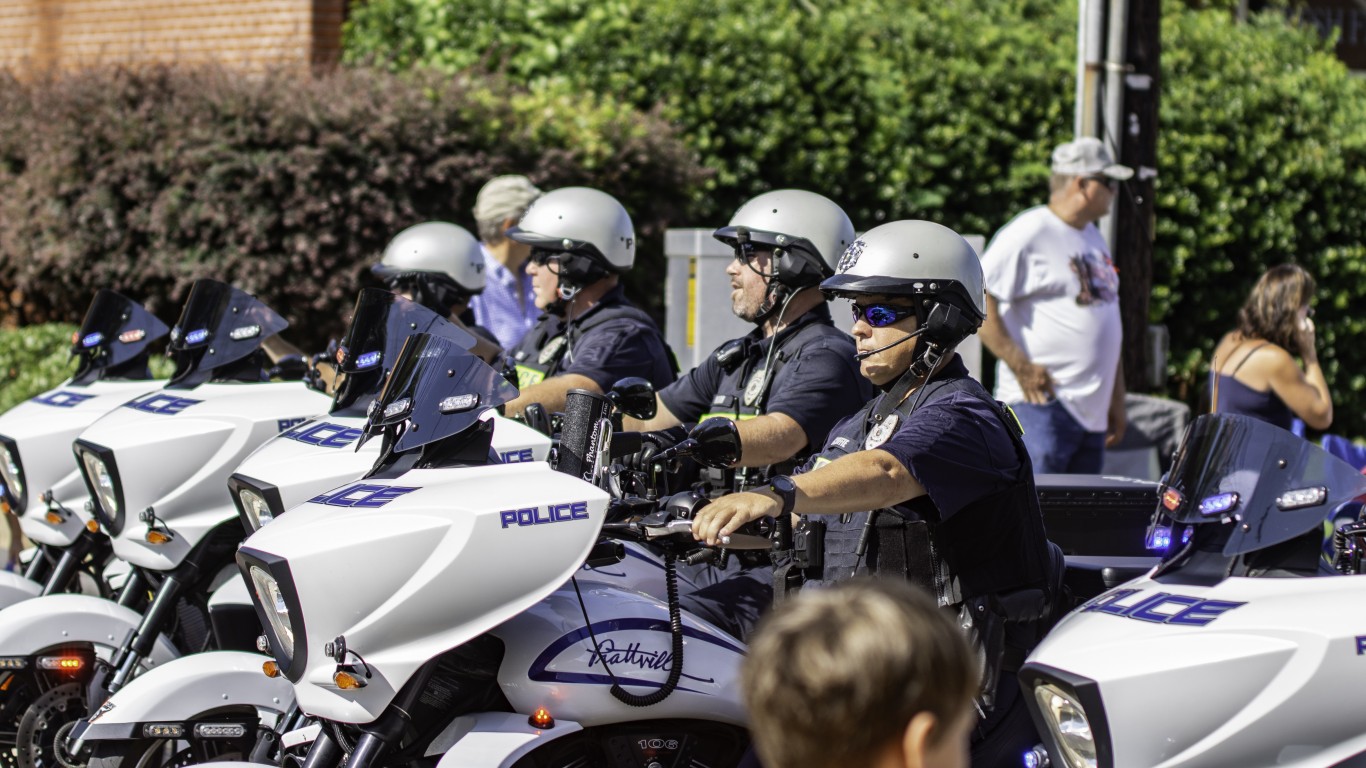
Alabama
> Police officers in 2021: 2.4 per 1,000 people (12,056 total)
> Police officers in 2020: 2.5 per 1,000 people (12,217 total)
> Pop. in jurisdictions covered by reporting agencies, 2021: 5,024,956 (near 100% of total state pop.)
> Pop. in jurisdictions covered by reporting agencies, 2020: 4,857,672 (99% of total state pop.)
[in-text-ad]
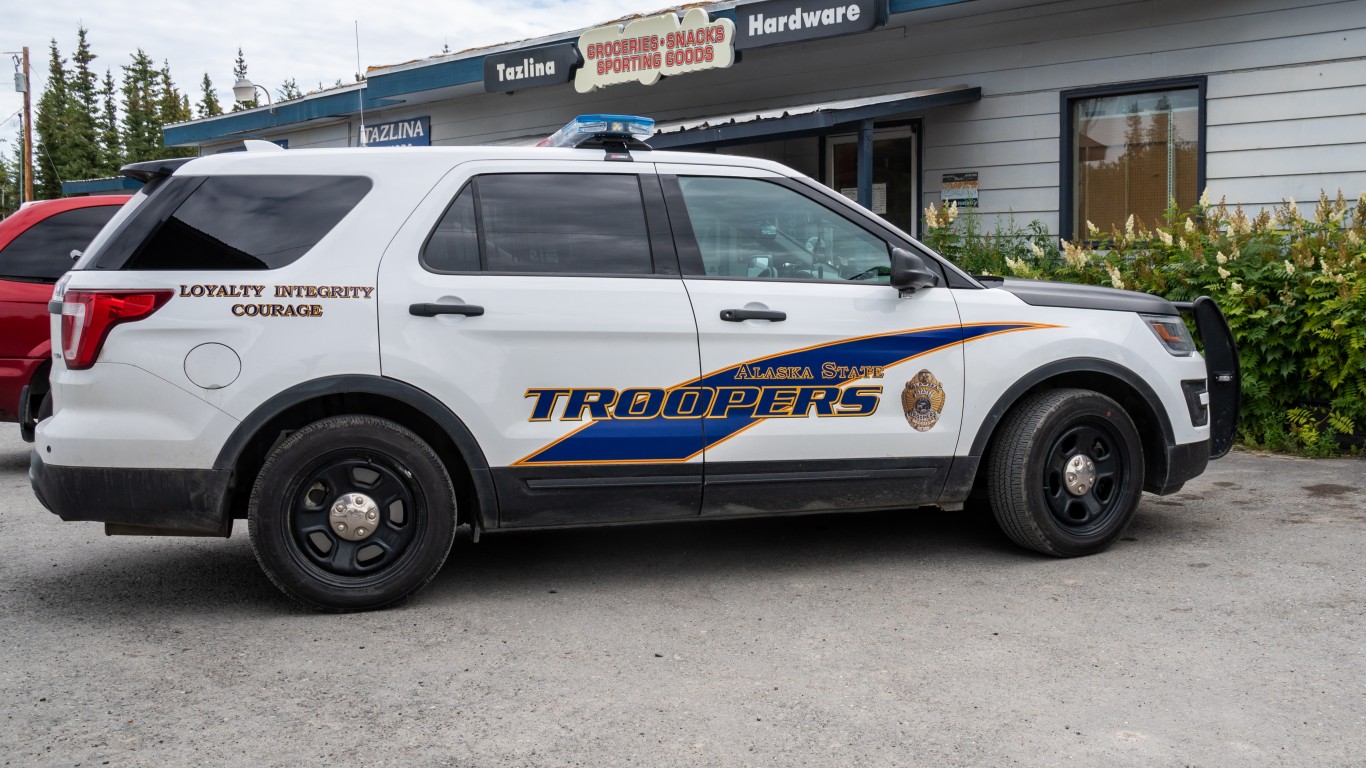
Alaska
> Police officers in 2021: 1.8 per 1,000 people (1,297 total)
> Police officers in 2020: 1.8 per 1,000 people (1,290 total)
> Pop. in jurisdictions covered by reporting agencies, 2021: 732,673 (near 100% of total state pop.)
> Pop. in jurisdictions covered by reporting agencies, 2020: 730,400 (near 100% of total state pop.)
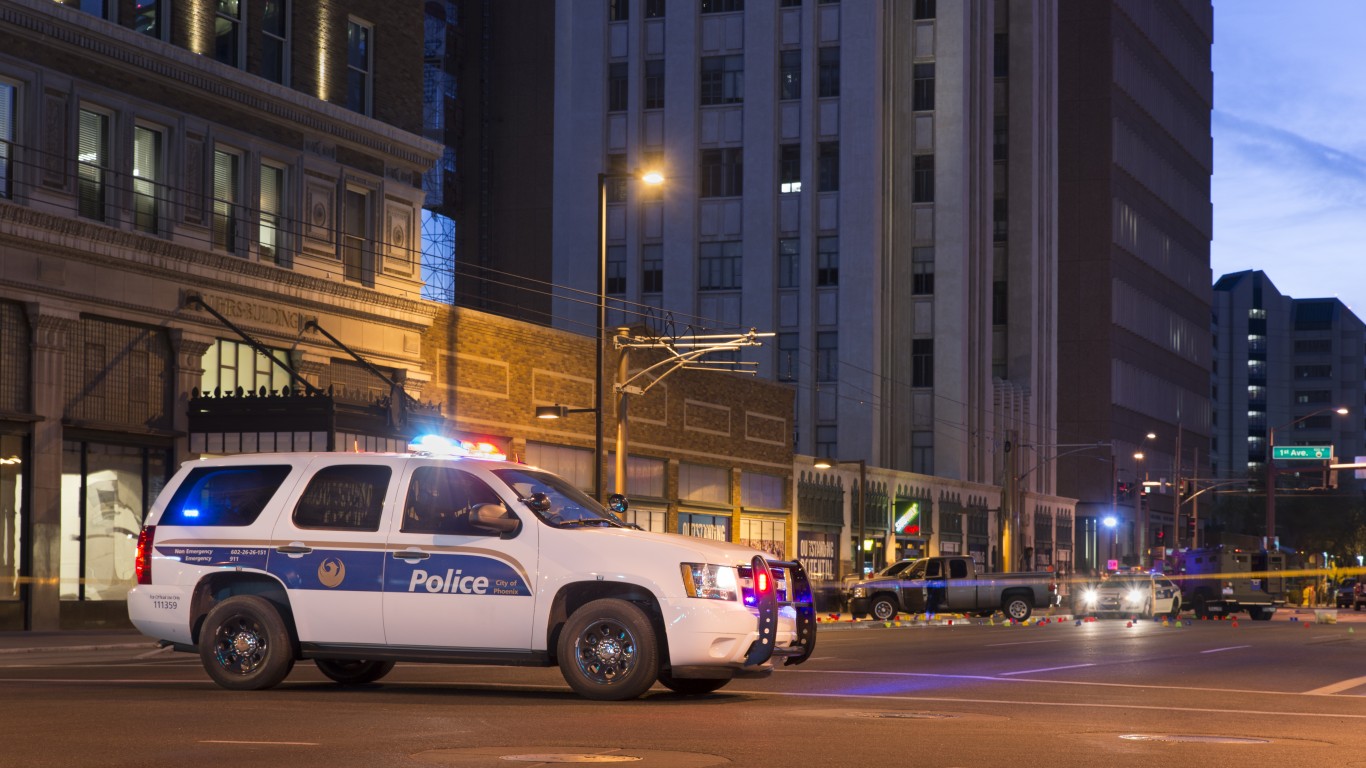
Arizona
> Police officers in 2021: 1.8 per 1,000 people (12,652 total)
> Police officers in 2020: 1.7 per 1,000 people (12,758 total)
> Pop. in jurisdictions covered by reporting agencies, 2021: 7,219,091 (99% of total state pop.)
> Pop. in jurisdictions covered by reporting agencies, 2020: 7,359,580 (near 100% of total state pop.)

Arkansas
> Police officers in 2021: 2.2 per 1,000 people (6,788 total)
> Police officers in 2020: 2.2 per 1,000 people (6,812 total)
> Pop. in jurisdictions covered by reporting agencies, 2021: 3,021,943 (near 100% of total state pop.)
> Pop. in jurisdictions covered by reporting agencies, 2020: 3,030,522 (near 100% of total state pop.)
[in-text-ad-2]
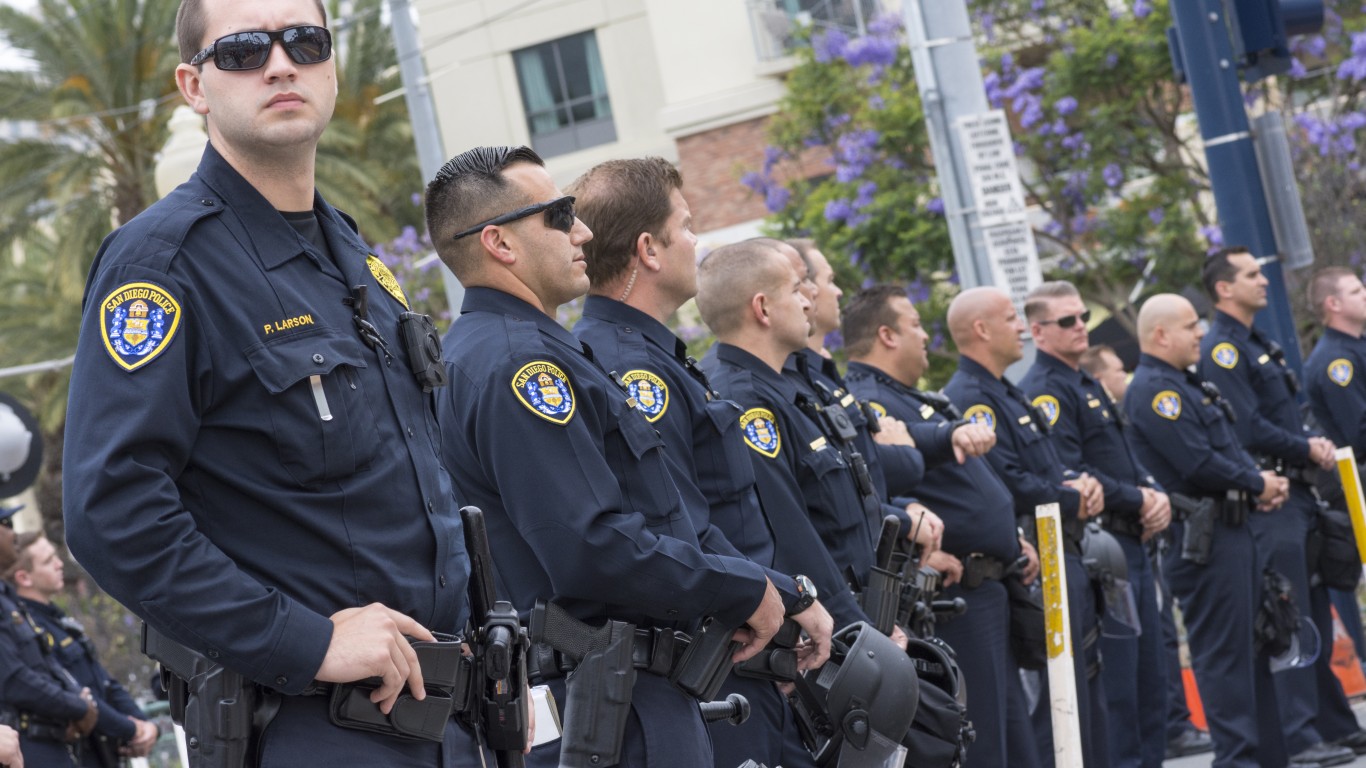
California
> Police officers in 2021: 2.3 per 1,000 people (77,621 total)
> Police officers in 2020: 2.0 per 1,000 people (79,636 total)
> Pop. in jurisdictions covered by reporting agencies, 2021: 33,681,412 (86% of total state pop.)
> Pop. in jurisdictions covered by reporting agencies, 2020: 39,361,017 (near 100% of total state pop.)
Colorado
> Police officers in 2021: 2.1 per 1,000 people (12,416 total)
> Police officers in 2020: 2.2 per 1,000 people (13,011 total)
> Pop. in jurisdictions covered by reporting agencies, 2021: 5,801,890 (near 100% of total state pop.)
> Pop. in jurisdictions covered by reporting agencies, 2020: 5,807,218 (near 100% of total state pop.)
[in-text-ad]

Connecticut
> Police officers in 2021: 2.1 per 1,000 people (7,557 total)
> Police officers in 2020: 2.2 per 1,000 people (7,706 total)
> Pop. in jurisdictions covered by reporting agencies, 2021: 3,605,597 (near 100% of total state pop.)
> Pop. in jurisdictions covered by reporting agencies, 2020: 3,557,006 (near 100% of total state pop.)
Delaware
> Police officers in 2021: 2.3 per 1,000 people (2,324 total)
> Police officers in 2020: 2.8 per 1,000 people (2,727 total)
> Pop. in jurisdictions covered by reporting agencies, 2021: 999,231 (near 100% of total state pop.)
> Pop. in jurisdictions covered by reporting agencies, 2020: 986,809 (near 100% of total state pop.)

Florida
> Police officers in 2021: 2.3 per 1,000 people (47,993 total)
> Police officers in 2020: 2.3 per 1,000 people (45,852 total)
> Pop. in jurisdictions covered by reporting agencies, 2021: 20,581,447 (94% of total state pop.)
> Pop. in jurisdictions covered by reporting agencies, 2020: 20,251,225 (94% of total state pop.)
[in-text-ad-2]

Georgia
> Police officers in 2021: 2.5 per 1,000 people (24,324 total)
> Police officers in 2020: 2.6 per 1,000 people (25,113 total)
> Pop. in jurisdictions covered by reporting agencies, 2021: 9,915,271 (92% of total state pop.)
> Pop. in jurisdictions covered by reporting agencies, 2020: 9,559,674 (90% of total state pop.)
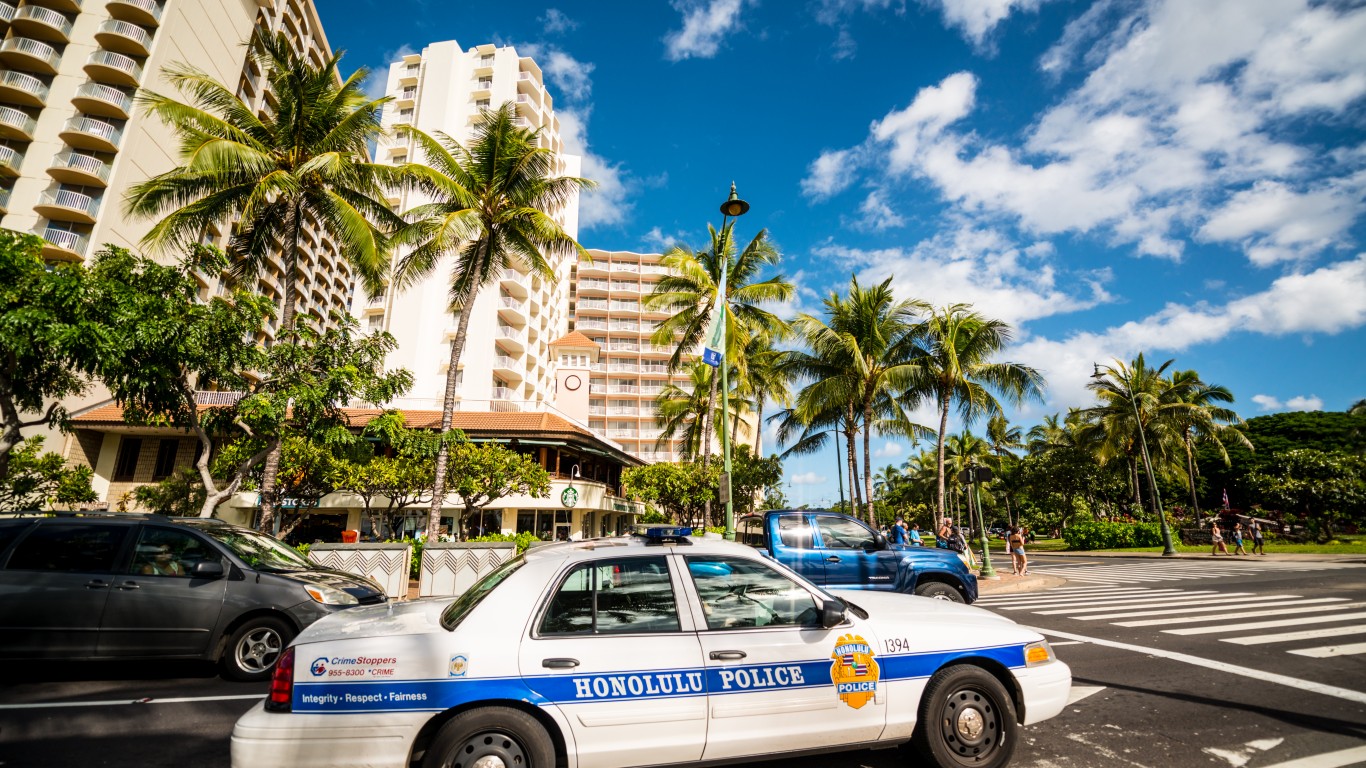
Hawaii
> Police officers in 2021: 2.0 per 1,000 people (2,828 total)
> Police officers in 2020: 2.1 per 1,000 people (2,896 total)
> Pop. in jurisdictions covered by reporting agencies, 2021: 1,441,553 (near 100% of total state pop.)
> Pop. in jurisdictions covered by reporting agencies, 2020: 1,407,006 (99% of total state pop.)
[in-text-ad]
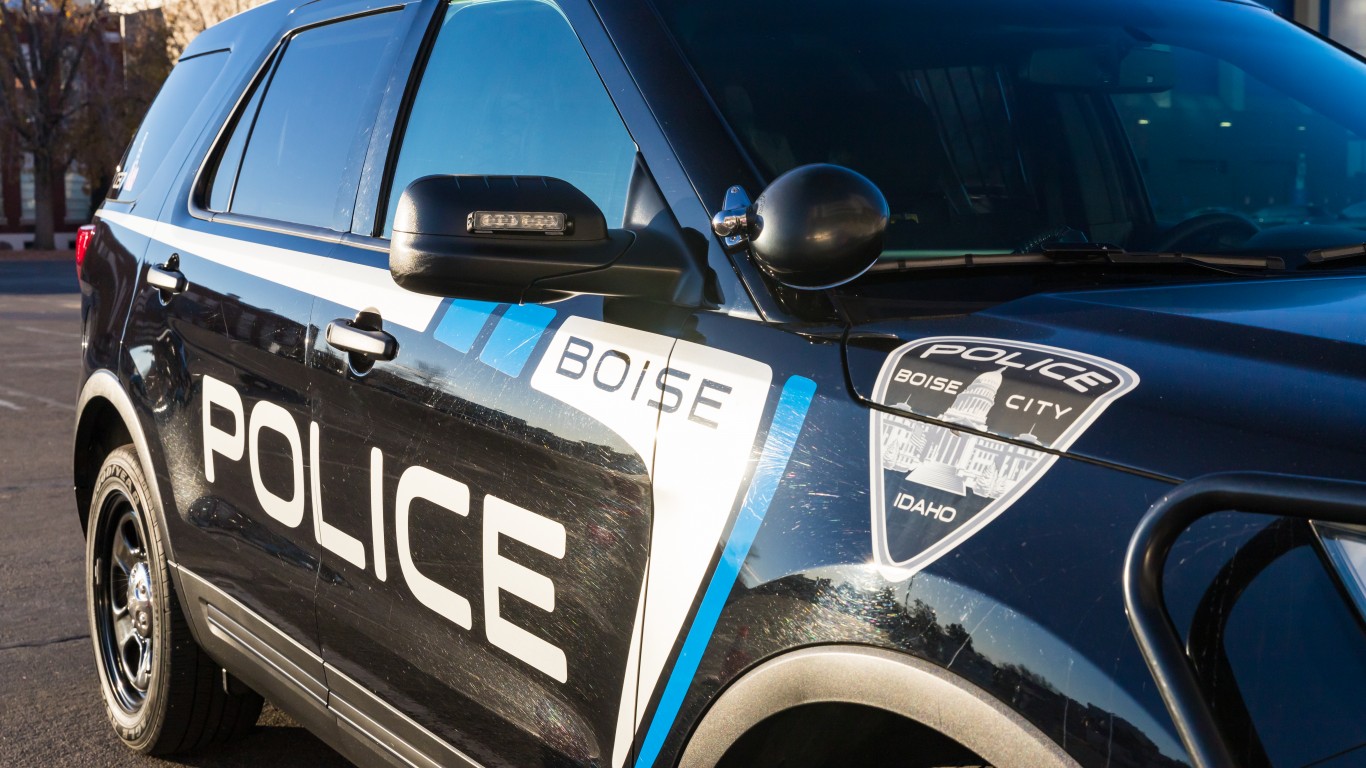
Idaho
> Police officers in 2021: 1.6 per 1,000 people (2,995 total)
> Police officers in 2020: 1.6 per 1,000 people (3,003 total)
> Pop. in jurisdictions covered by reporting agencies, 2021: 1,884,072 (99% of total state pop.)
> Pop. in jurisdictions covered by reporting agencies, 2020: 1,826,913 (near 100% of total state pop.)
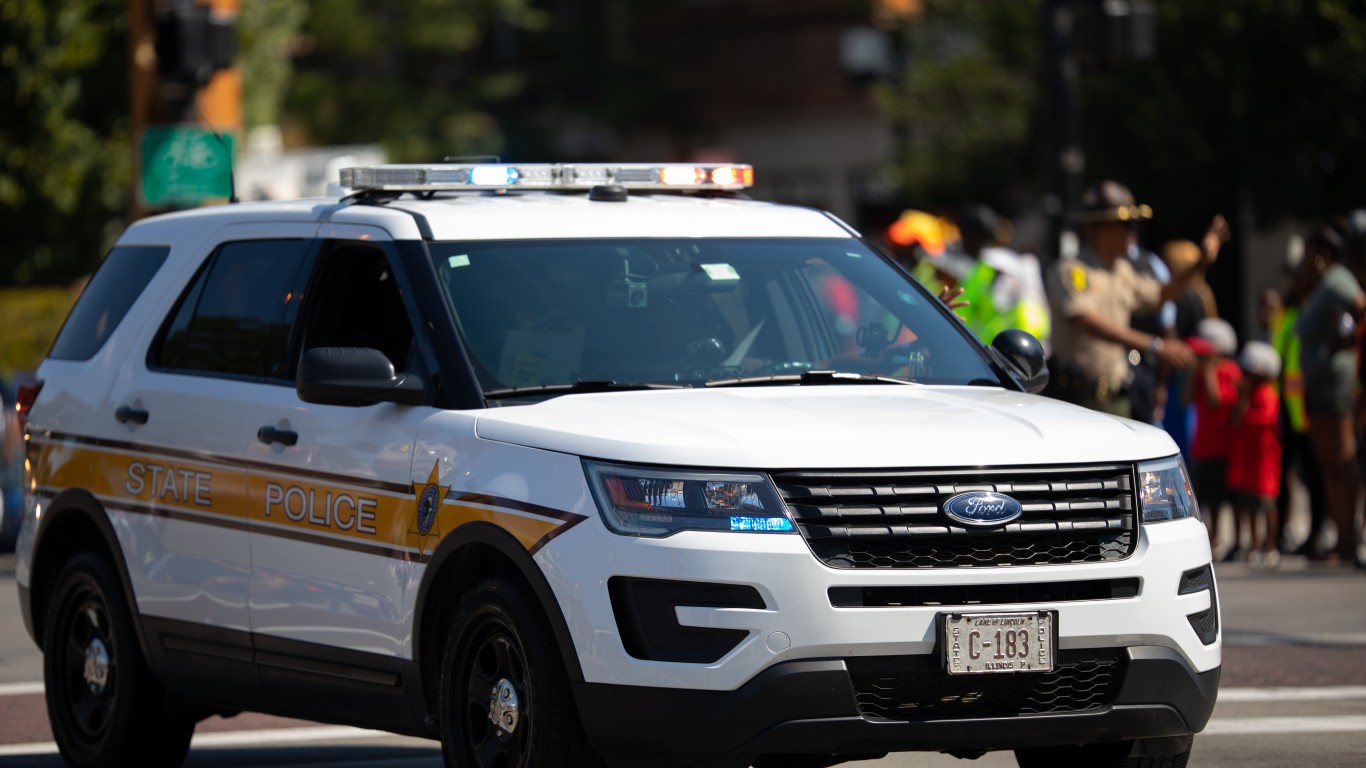
Illinois
> Insufficient reporting from local police departments

Indiana
> Insufficient reporting from local police departments
[in-text-ad-2]
Iowa
> Police officers in 2021: 1.8 per 1,000 people (5,251 total)
> Police officers in 2020: 1.8 per 1,000 people (5,413 total)
> Pop. in jurisdictions covered by reporting agencies, 2021: 2,982,692 (93% of total state pop.)
> Pop. in jurisdictions covered by reporting agencies, 2020: 3,080,722 (98% of total state pop.)
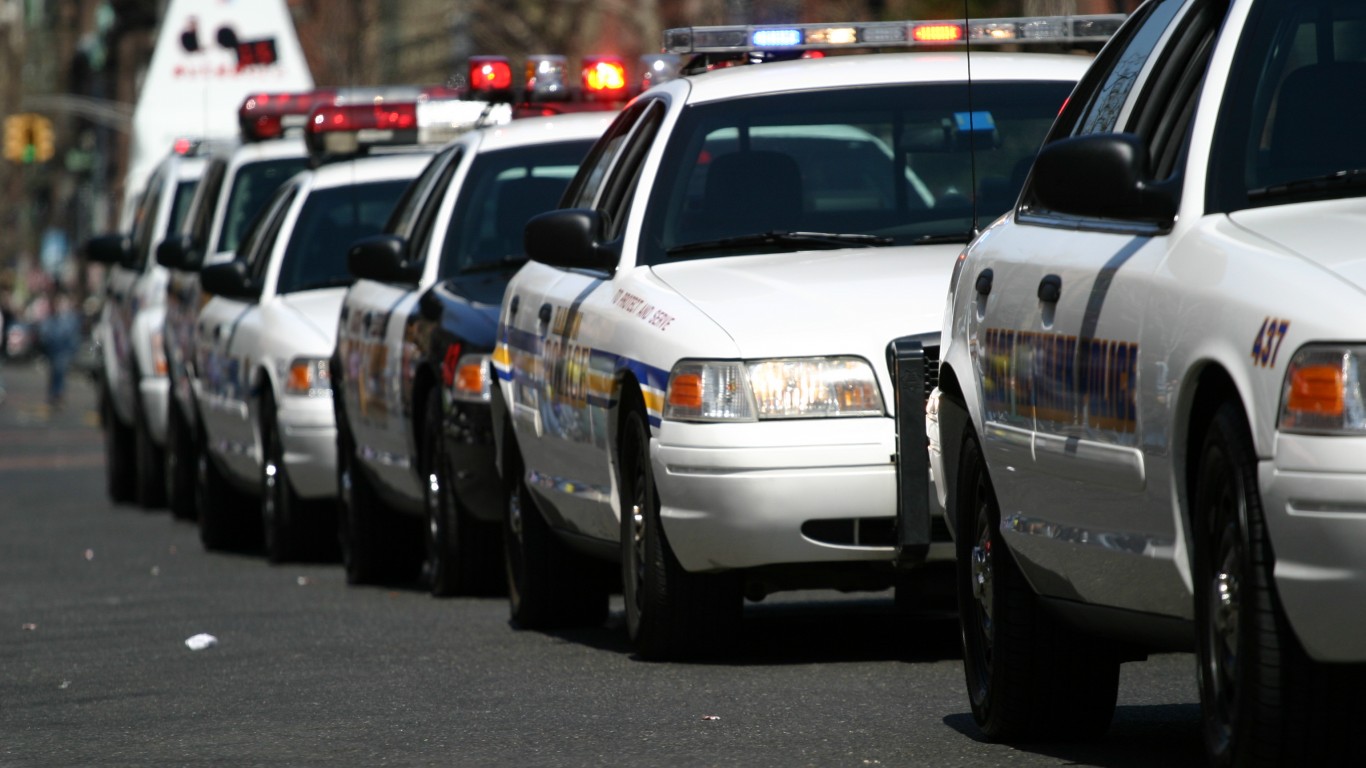
Kansas
> Insufficient reporting from local police departments
[in-text-ad]

Kentucky
> Police officers in 2021: 1.9 per 1,000 people (7,494 total)
> Police officers in 2020: 1.9 per 1,000 people (7,458 total)
> Pop. in jurisdictions covered by reporting agencies, 2021: 3,971,950 (88% of total state pop.)
> Pop. in jurisdictions covered by reporting agencies, 2020: 3,829,479 (86% of total state pop.)

Louisiana
> Insufficient reporting from local police departments

Maine
> Police officers in 2021: 1.7 per 1,000 people (2,348 total)
> Police officers in 2020: 1.7 per 1,000 people (2,358 total)
> Pop. in jurisdictions covered by reporting agencies, 2021: 1,370,436 (near 100% of total state pop.)
> Pop. in jurisdictions covered by reporting agencies, 2020: 1,350,141 (near 100% of total state pop.)
[in-text-ad-2]

Maryland
> Police officers in 2021: 2.5 per 1,000 people (15,184 total)
> Police officers in 2020: 2.8 per 1,000 people (16,774 total)
> Pop. in jurisdictions covered by reporting agencies, 2021: 6,148,883 (near 100% of total state pop.)
> Pop. in jurisdictions covered by reporting agencies, 2020: 6,036,961 (near 100% of total state pop.)
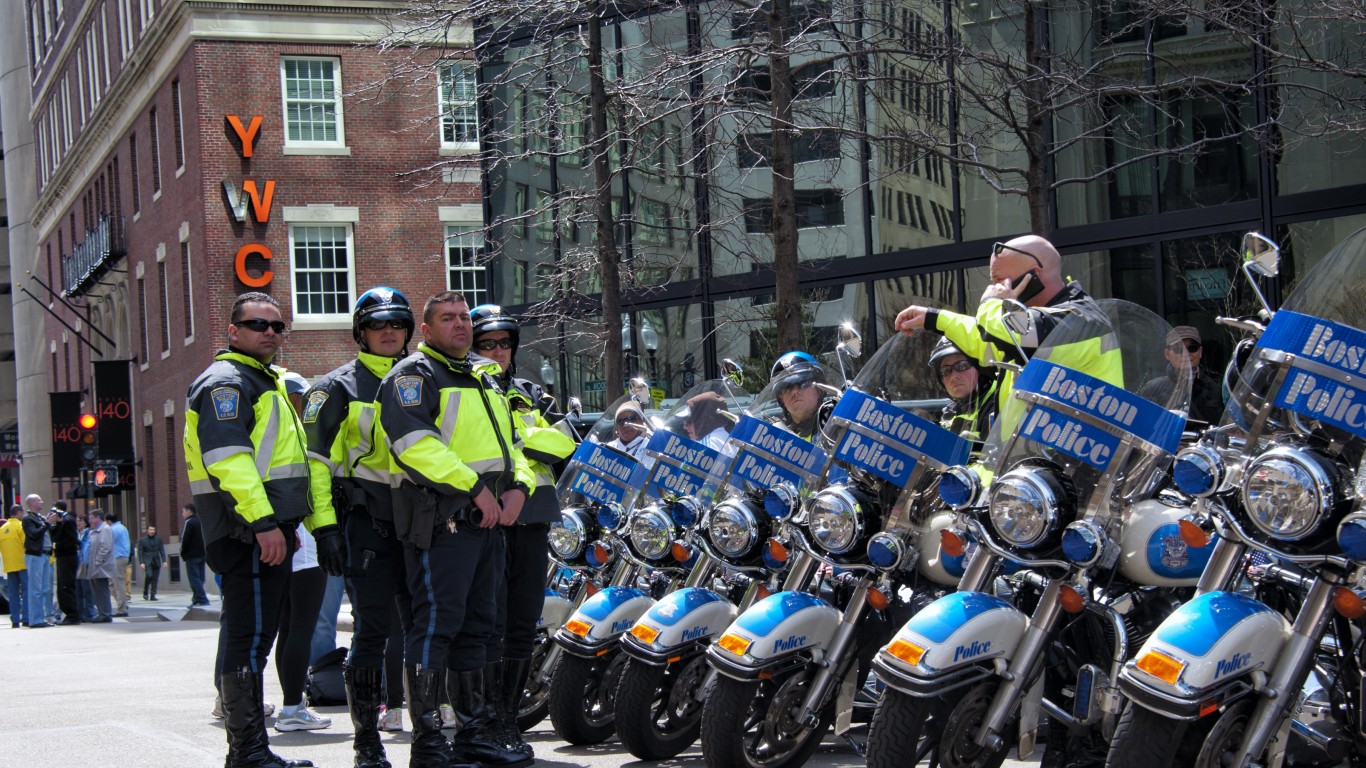
Massachusetts
> Police officers in 2021: 2.5 per 1,000 people (15,923 total)
> Police officers in 2020: 2.6 per 1,000 people (16,719 total)
> Pop. in jurisdictions covered by reporting agencies, 2021: 6,294,191 (90% of total state pop.)
> Pop. in jurisdictions covered by reporting agencies, 2020: 6,474,973 (94% of total state pop.)
[in-text-ad]

Michigan
> Police officers in 2021: 1.9 per 1,000 people (17,961 total)
> Police officers in 2020: 1.8 per 1,000 people (17,998 total)
> Pop. in jurisdictions covered by reporting agencies, 2021: 9,663,515 (96% of total state pop.)
> Pop. in jurisdictions covered by reporting agencies, 2020: 9,953,031 (near 100% of total state pop.)
Minnesota
> Police officers in 2021: 1.8 per 1,000 people (10,041 total)
> Police officers in 2020: 1.8 per 1,000 people (9,981 total)
> Pop. in jurisdictions covered by reporting agencies, 2021: 5,694,465 (near 100% of total state pop.)
> Pop. in jurisdictions covered by reporting agencies, 2020: 5,645,848 (near 100% of total state pop.)

Mississippi
> Insufficient reporting from local police departments
[in-text-ad-2]

Missouri
> Insufficient reporting from local police departments

Montana
> Police officers in 2021: 1.8 per 1,000 people (2,032 total)
> Police officers in 2020: 2.0 per 1,000 people (2,119 total)
> Pop. in jurisdictions covered by reporting agencies, 2021: 1,104,271 (near 100% of total state pop.)
> Pop. in jurisdictions covered by reporting agencies, 2020: 1,077,405 (near 100% of total state pop.)
[in-text-ad]
Nebraska
> Police officers in 2021: 2.0 per 1,000 people (3,798 total)
> Police officers in 2020: 2.0 per 1,000 people (3,707 total)
> Pop. in jurisdictions covered by reporting agencies, 2021: 1,888,040 (96% of total state pop.)
> Pop. in jurisdictions covered by reporting agencies, 2020: 1,879,643 (97% of total state pop.)
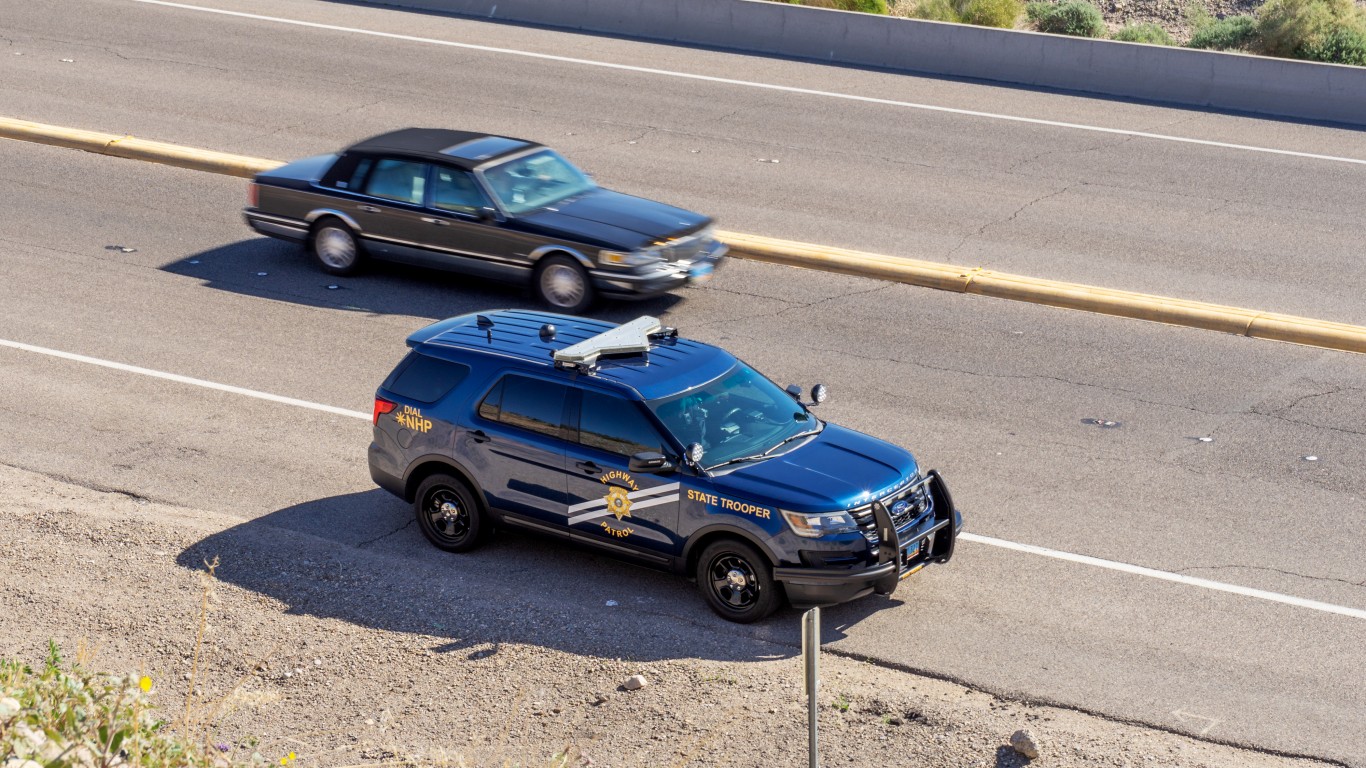
Nevada
> Police officers in 2021: 2.6 per 1,000 people (7,136 total)
> Police officers in 2020: 2.6 per 1,000 people (7,424 total)
> Pop. in jurisdictions covered by reporting agencies, 2021: 2,738,311 (87% of total state pop.)
> Pop. in jurisdictions covered by reporting agencies, 2020: 2,882,042 (94% of total state pop.)

New Hampshire
> Police officers in 2021: 2.1 per 1,000 people (2,871 total)
> Police officers in 2020: 2.2 per 1,000 people (2,863 total)
> Pop. in jurisdictions covered by reporting agencies, 2021: 1,339,962 (96% of total state pop.)
> Pop. in jurisdictions covered by reporting agencies, 2020: 1,312,533 (97% of total state pop.)
[in-text-ad-2]
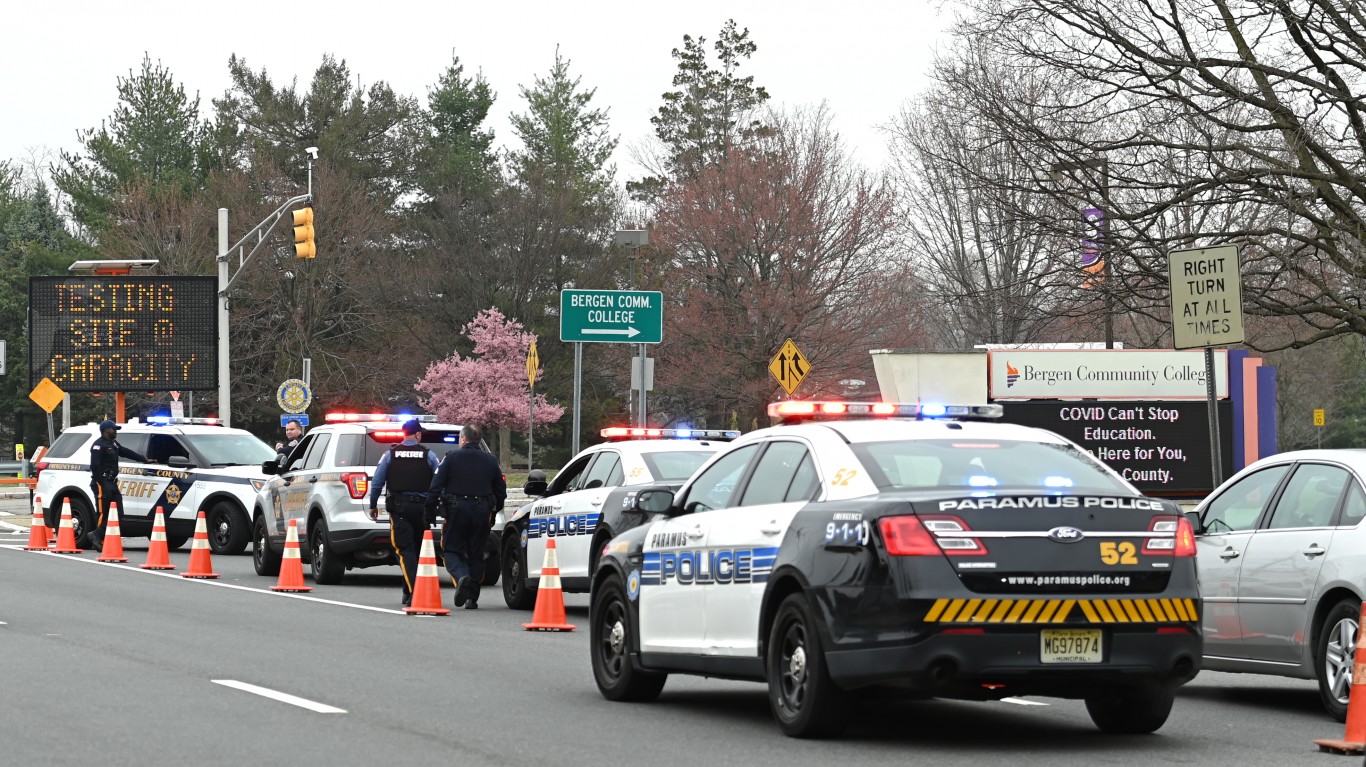
New Jersey
> Police officers in 2021: 4.3 per 1,000 people (38,223 total)
> Police officers in 2020: 4.4 per 1,000 people (38,760 total)
> Pop. in jurisdictions covered by reporting agencies, 2021: 8,882,067 (96% of total state pop.)
> Pop. in jurisdictions covered by reporting agencies, 2020: 8,838,107 (near 100% of total state pop.)

New Mexico
> Insufficient reporting from local police departments
[in-text-ad]

New York
> Police officers in 2021: 3.3 per 1,000 people (58,388 total)
> Police officers in 2020: 3.4 per 1,000 people (57,745 total)
> Pop. in jurisdictions covered by reporting agencies, 2021: 17,797,949 (90% of total state pop.)
> Pop. in jurisdictions covered by reporting agencies, 2020: 17,174,129 (88% of total state pop.)
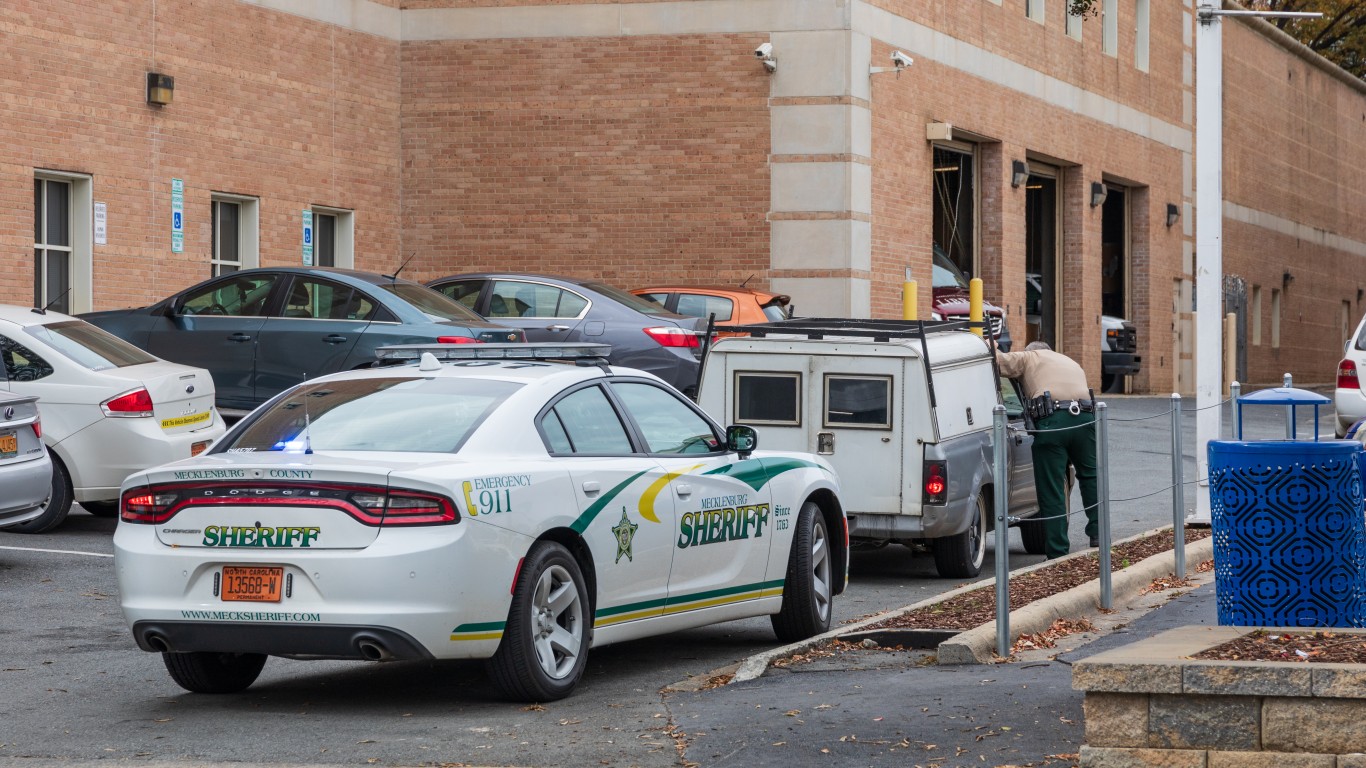
North Carolina
> Police officers in 2021: 2.3 per 1,000 people (23,788 total)
> Police officers in 2020: 2.3 per 1,000 people (24,508 total)
> Pop. in jurisdictions covered by reporting agencies, 2021: 10,533,622 (near 100% of total state pop.)
> Pop. in jurisdictions covered by reporting agencies, 2020: 10,599,901 (near 100% of total state pop.)
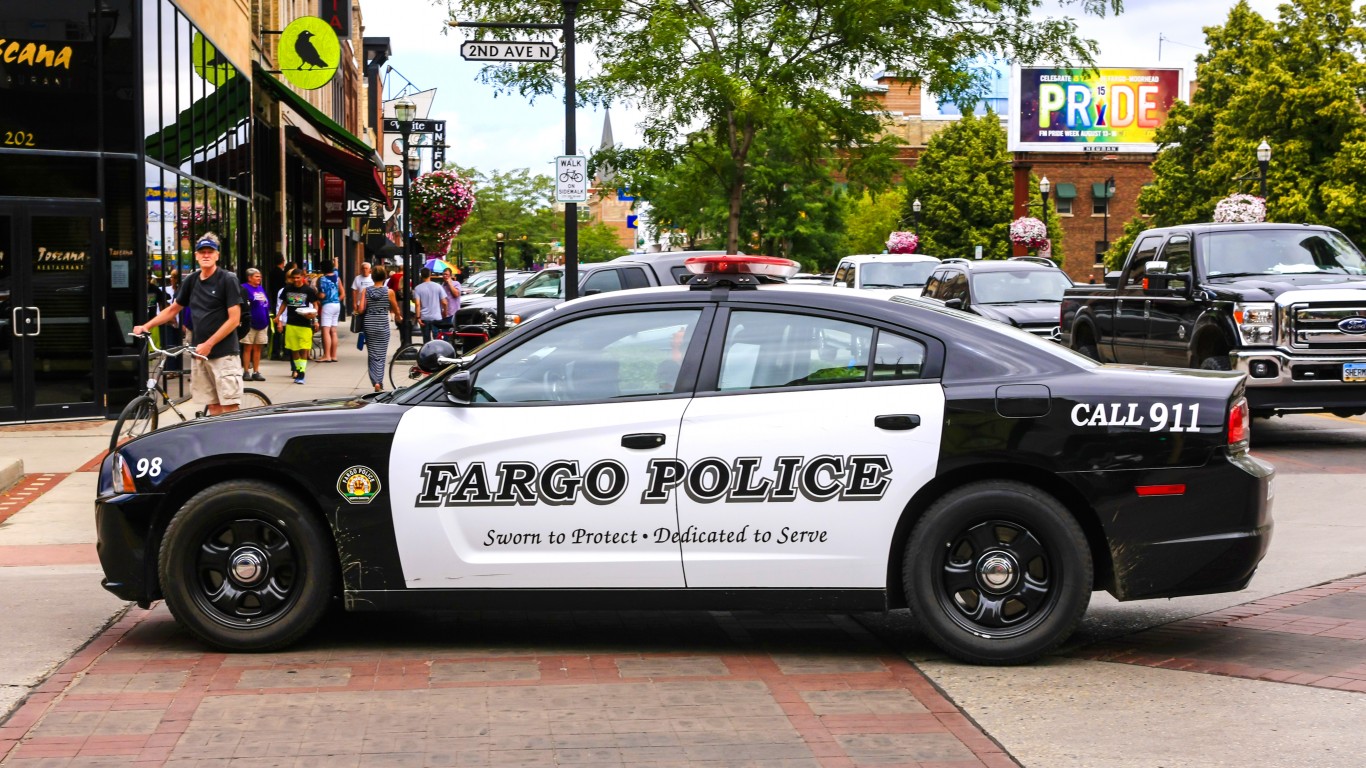
North Dakota
> Police officers in 2021: 2.5 per 1,000 people (1,908 total)
> Police officers in 2020: 2.4 per 1,000 people (1,830 total)
> Pop. in jurisdictions covered by reporting agencies, 2021: 773,166 (near 100% of total state pop.)
> Pop. in jurisdictions covered by reporting agencies, 2020: 763,847 (near 100% of total state pop.)
[in-text-ad-2]
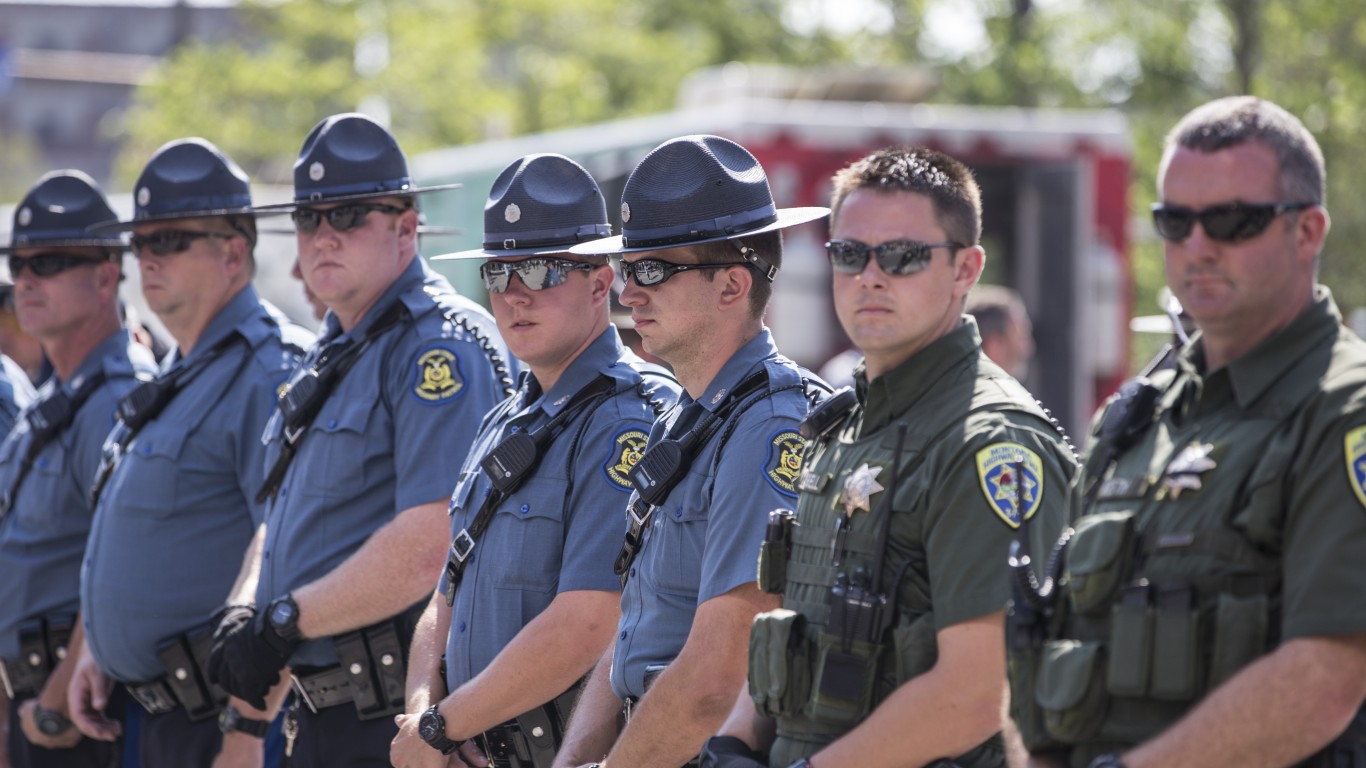
Ohio
> Insufficient reporting from local police departments
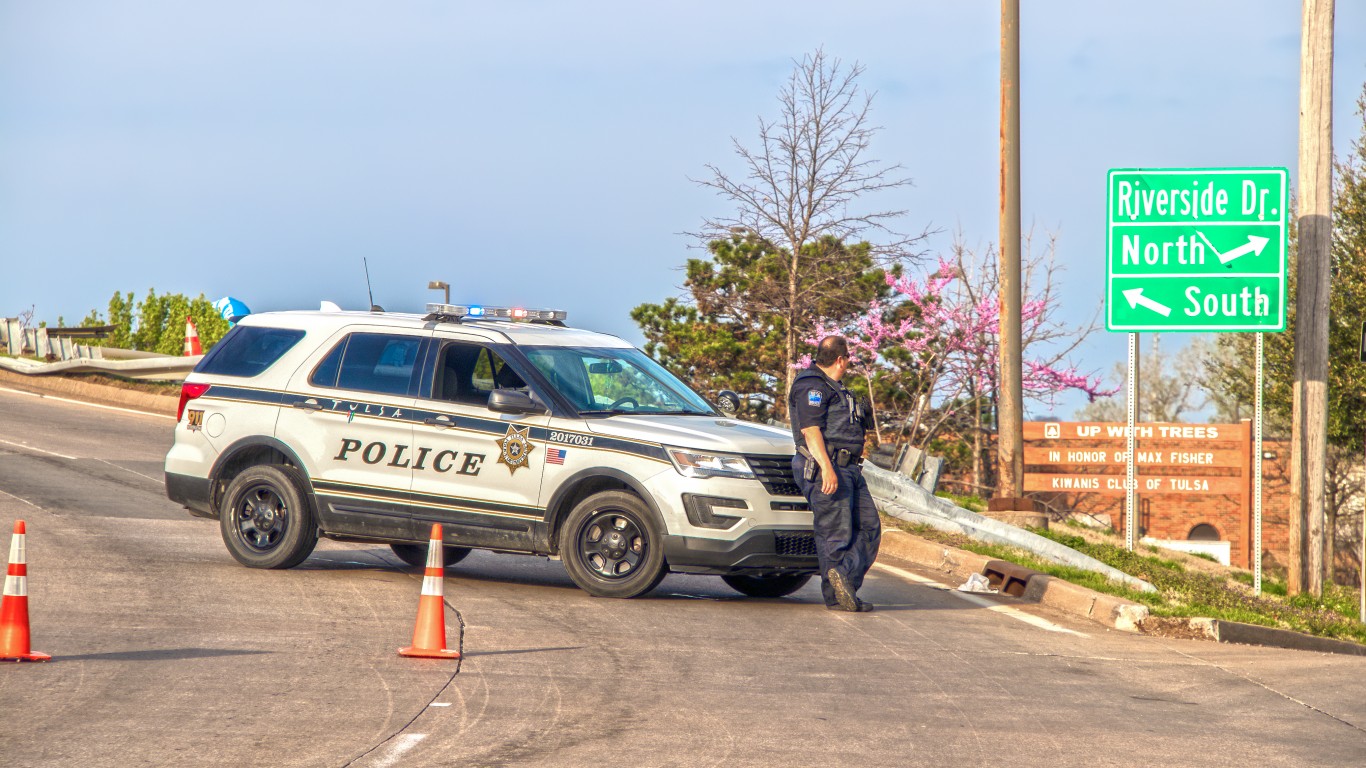
Oklahoma
> Police officers in 2021: 2.3 per 1,000 people (9,025 total)
> Police officers in 2020: 2.2 per 1,000 people (8,796 total)
> Pop. in jurisdictions covered by reporting agencies, 2021: 3,981,345 (near 100% of total state pop.)
> Pop. in jurisdictions covered by reporting agencies, 2020: 3,980,783 (near 100% of total state pop.)
[in-text-ad]
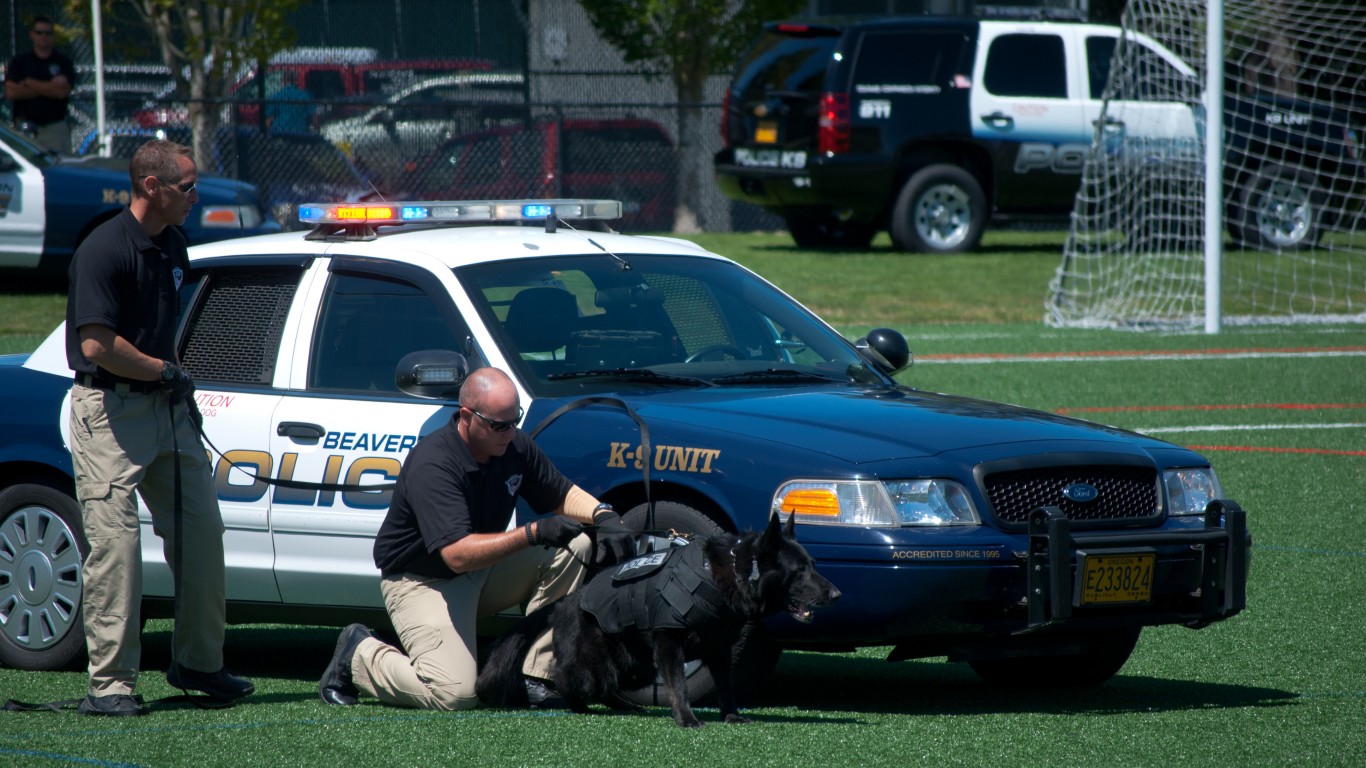
Oregon
> Police officers in 2021: 1.5 per 1,000 people (6,286 total)
> Police officers in 2020: 1.5 per 1,000 people (6,481 total)
> Pop. in jurisdictions covered by reporting agencies, 2021: 4,246,155 (near 100% of total state pop.)
> Pop. in jurisdictions covered by reporting agencies, 2020: 4,223,556 (near 100% of total state pop.)

Pennsylvania
> Insufficient reporting from local police departments
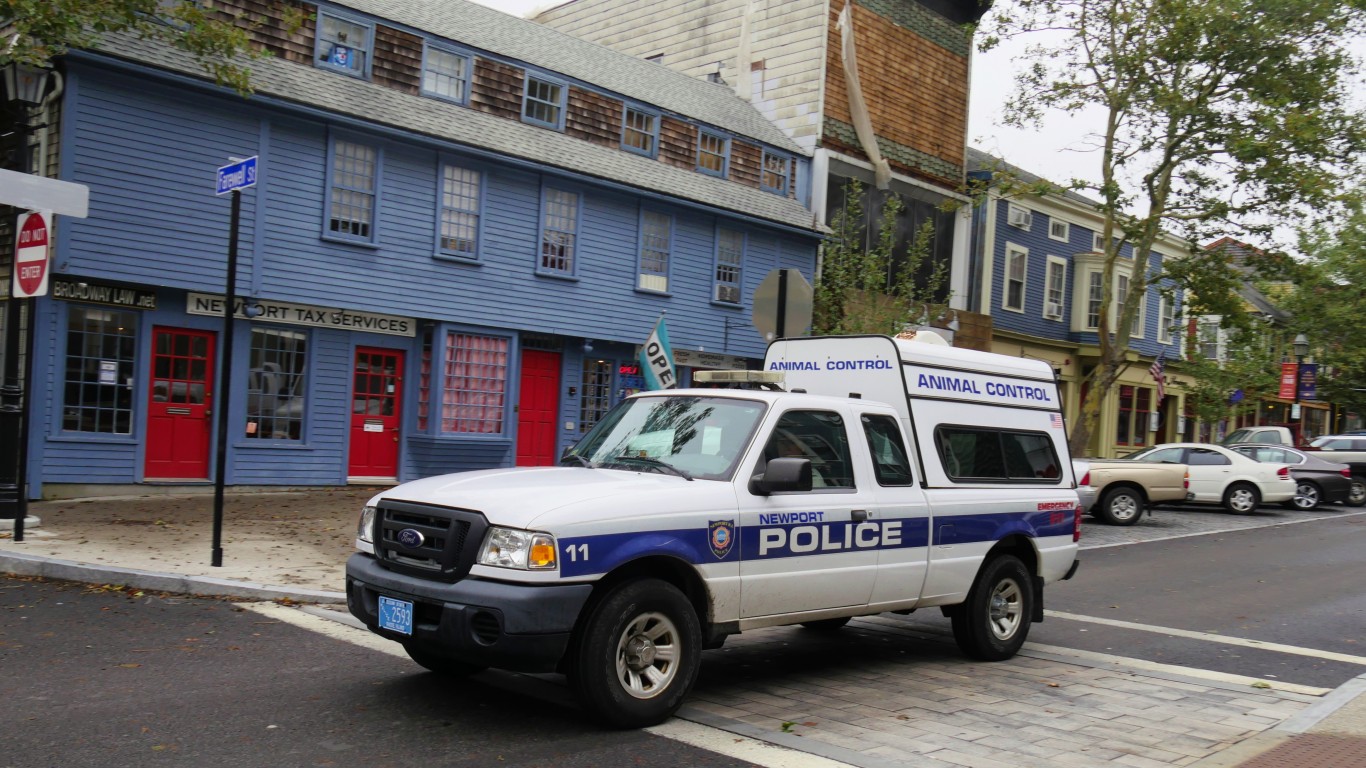
Rhode Island
> Police officers in 2021: 2.3 per 1,000 people (2,491 total)
> Police officers in 2020: 2.4 per 1,000 people (2,515 total)
> Pop. in jurisdictions covered by reporting agencies, 2021: 1,095,610 (near 100% of total state pop.)
> Pop. in jurisdictions covered by reporting agencies, 2020: 1,057,125 (near 100% of total state pop.)
[in-text-ad-2]
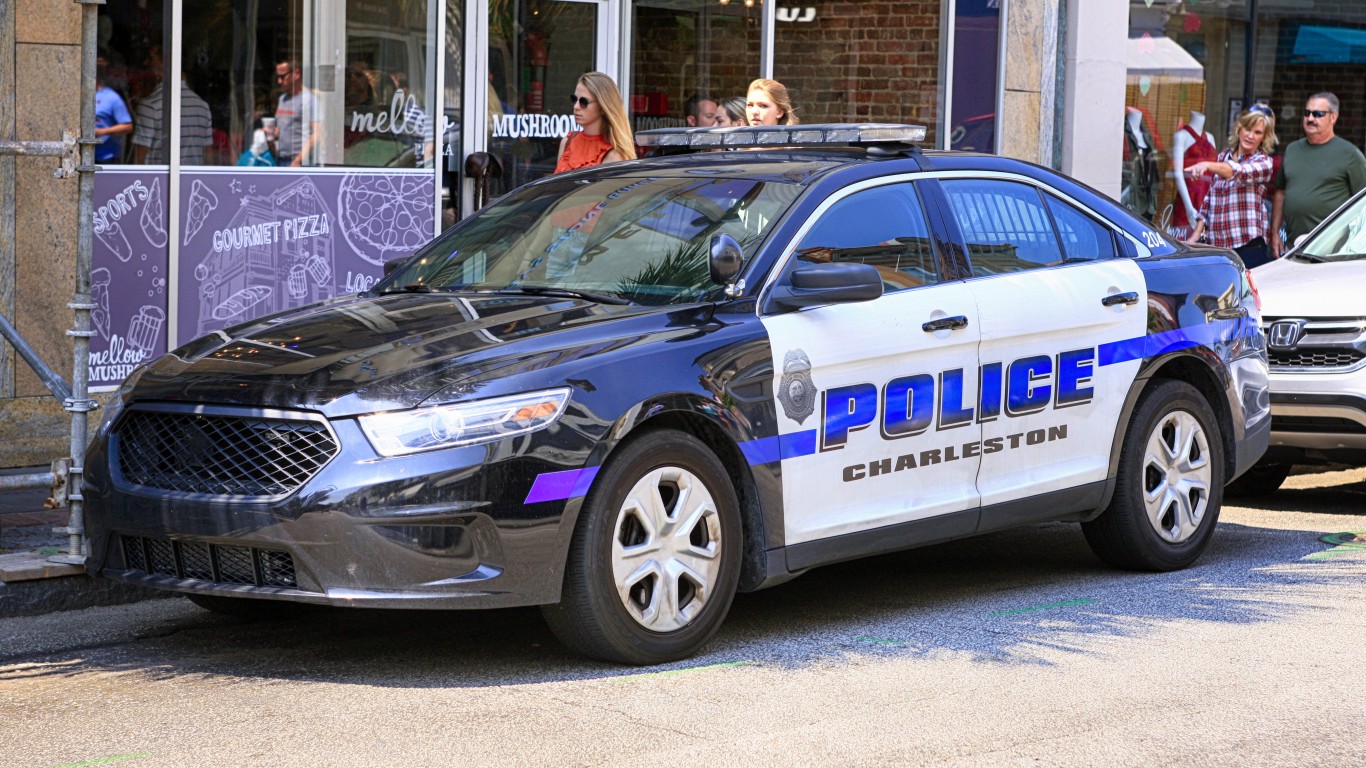
South Carolina
> Police officers in 2021: 2.2 per 1,000 people (10,642 total)
> Police officers in 2020: 2.3 per 1,000 people (11,908 total)
> Pop. in jurisdictions covered by reporting agencies, 2021: 4,823,991 (93% of total state pop.)
> Pop. in jurisdictions covered by reporting agencies, 2020: 5,079,159 (99% of total state pop.)

South Dakota
> Police officers in 2021: 2.2 per 1,000 people (1,935 total)
> Police officers in 2020: 2.0 per 1,000 people (1,823 total)
> Pop. in jurisdictions covered by reporting agencies, 2021: 880,991 (98% of total state pop.)
> Pop. in jurisdictions covered by reporting agencies, 2020: 891,765 (near 100% of total state pop.)
[in-text-ad]

Tennessee
> Police officers in 2021: 2.6 per 1,000 people (17,886 total)
> Police officers in 2020: 2.6 per 1,000 people (17,785 total)
> Pop. in jurisdictions covered by reporting agencies, 2021: 6,971,448 (near 100% of total state pop.)
> Pop. in jurisdictions covered by reporting agencies, 2020: 6,886,834 (near 100% of total state pop.)

Texas
> Police officers in 2021: 2.1 per 1,000 people (59,121 total)
> Police officers in 2020: 2.0 per 1,000 people (58,723 total)
> Pop. in jurisdictions covered by reporting agencies, 2021: 28,550,468 (97% of total state pop.)
> Pop. in jurisdictions covered by reporting agencies, 2020: 28,663,886 (99% of total state pop.)
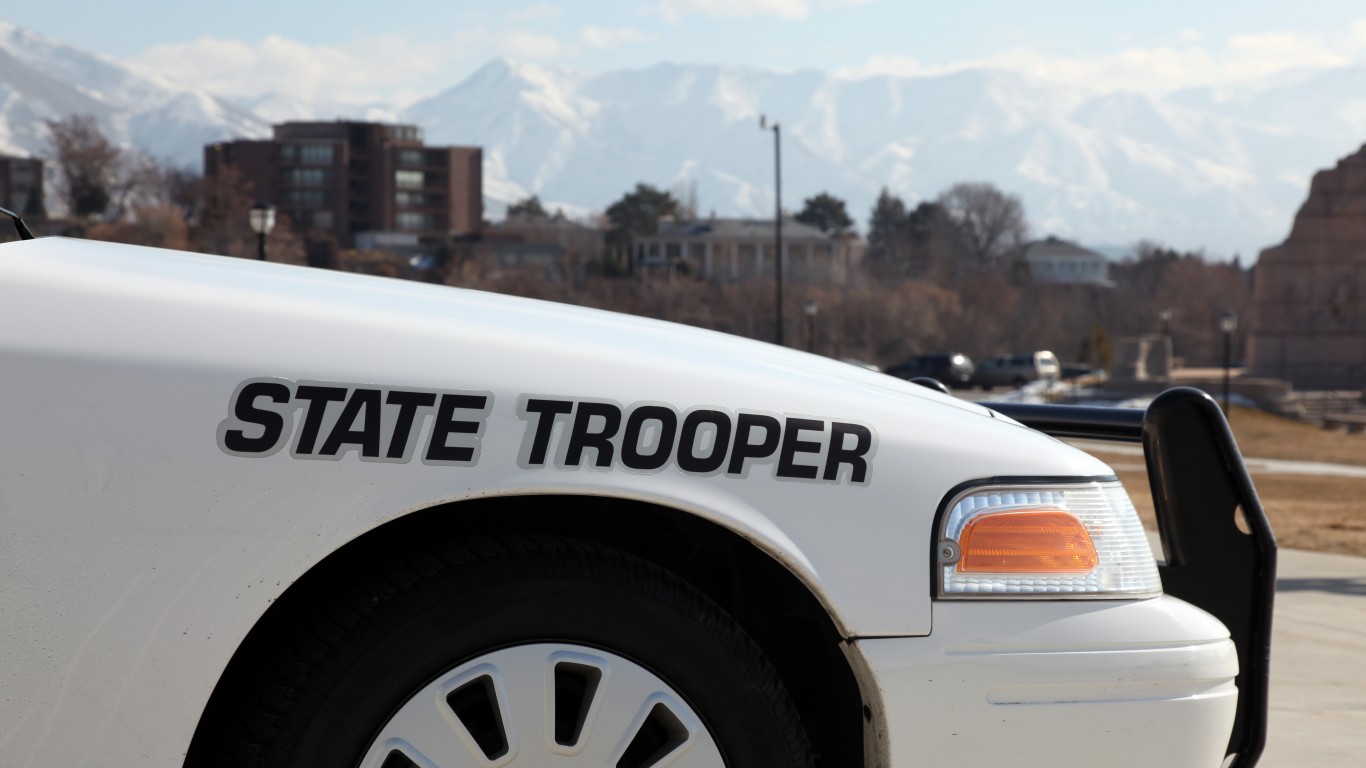
Utah
> Police officers in 2021: 1.6 per 1,000 people (5,446 total)
> Police officers in 2020: 1.7 per 1,000 people (5,399 total)
> Pop. in jurisdictions covered by reporting agencies, 2021: 3,324,060 (near 100% of total state pop.)
> Pop. in jurisdictions covered by reporting agencies, 2020: 3,244,755 (near 100% of total state pop.)
[in-text-ad-2]

Vermont
> Police officers in 2021: 1.7 per 1,000 people (1,089 total)
> Police officers in 2020: 1.9 per 1,000 people (1,203 total)
> Pop. in jurisdictions covered by reporting agencies, 2021: 644,595 (near 100% of total state pop.)
> Pop. in jurisdictions covered by reporting agencies, 2020: 623,347 (near 100% of total state pop.)

Virginia
> Police officers in 2021: 2.2 per 1,000 people (18,542 total)
> Police officers in 2020: 2.3 per 1,000 people (19,875 total)
> Pop. in jurisdictions covered by reporting agencies, 2021: 8,489,762 (98% of total state pop.)
> Pop. in jurisdictions covered by reporting agencies, 2020: 8,590,563 (near 100% of total state pop.)
[in-text-ad]
Washington
> Police officers in 2021: 1.4 per 1,000 people (10,431 total)
> Police officers in 2020: 1.4 per 1,000 people (10,973 total)
> Pop. in jurisdictions covered by reporting agencies, 2021: 7,705,506 (near 100% of total state pop.)
> Pop. in jurisdictions covered by reporting agencies, 2020: 7,693,612 (near 100% of total state pop.)

West Virginia
> Police officers in 2021: 2.0 per 1,000 people (3,456 total)
> Police officers in 2020: 2.3 per 1,000 people (4,119 total)
> Pop. in jurisdictions covered by reporting agencies, 2021: 1,768,313 (99% of total state pop.)
> Pop. in jurisdictions covered by reporting agencies, 2020: 1,784,787 (near 100% of total state pop.)
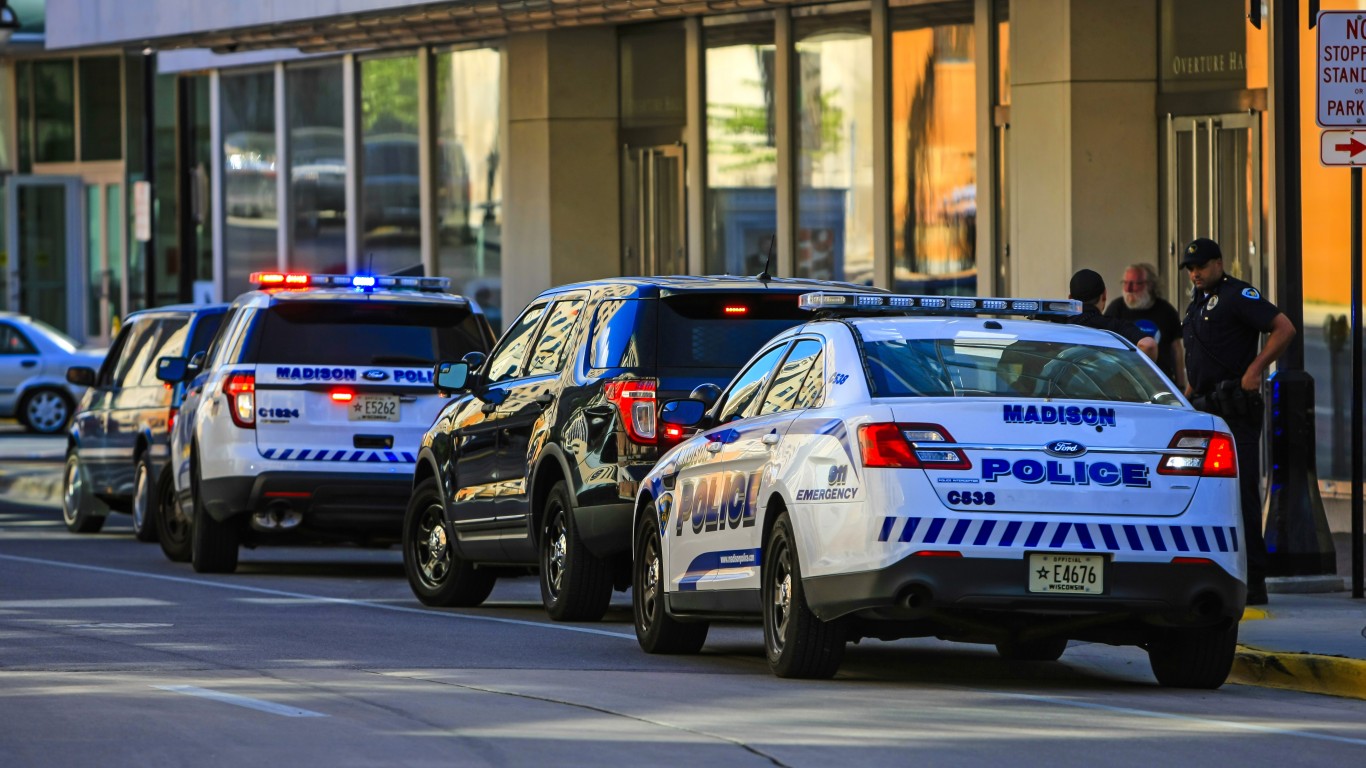
Wisconsin
> Police officers in 2021: 2.1 per 1,000 people (11,105 total)
> Police officers in 2020: 2.1 per 1,000 people (12,106 total)
> Pop. in jurisdictions covered by reporting agencies, 2021: 5,370,316 (91% of total state pop.)
> Pop. in jurisdictions covered by reporting agencies, 2020: 5,756,232 (99% of total state pop.)
[in-text-ad-2]
Wyoming
> Police officers in 2021: 2.8 per 1,000 people (1,551 total)
> Police officers in 2020: 2.7 per 1,000 people (1,534 total)
> Pop. in jurisdictions covered by reporting agencies, 2021: 558,398 (96% of total state pop.)
> Pop. in jurisdictions covered by reporting agencies, 2020: 560,518 (97% of total state pop.)
Methodology
To identify how the size of each state’s police force changed in the last year, 24/7 Wall St. reviewed FBI data on the number of police officers in each state for every 1,000 people in covered jurisdictions.
FBI data is dependent on local police agencies reporting personnel data, and as a result, coverage within a given state is not always complete. For the purposes of this story, only states in which at least 85% of the total population reside in jurisdictions of police agencies that reported data to the FBI were considered. Based on this criteria, nine states were excluded from analysis.
Total population data used to calculate jurisdiction coverage in 2021 came from the U.S. Census Bureau’s 2021 American Community Survey. For 2020, we used one-year population data from the 2019 ACS, as complications from the COVID-19 pandemic prevented the release of 2020 estimates.
Only counts of police officers were considered, while civilian police employees, such as clerks and radio dispatchers, were excluded from police headcounts. The FBI defines police officers “as individuals who ordinarily carry a firearm and a badge, have full arrest powers, and are paid from governmental funds set aside specifically for sworn law enforcement representatives.”
After two decades of reviewing financial products I haven’t seen anything like this. Credit card companies are at war, handing out free rewards and benefits to win the best customers.
A good cash back card can be worth thousands of dollars a year in free money, not to mention other perks like travel, insurance, and access to fancy lounges.
Our top pick today pays up to 5% cash back, a $200 bonus on top, and $0 annual fee. Click here to apply before they stop offering rewards this generous.
Flywheel Publishing has partnered with CardRatings for our coverage of credit card products. Flywheel Publishing and CardRatings may receive a commission from card issuers.
Thank you for reading! Have some feedback for us?
Contact the 24/7 Wall St. editorial team.